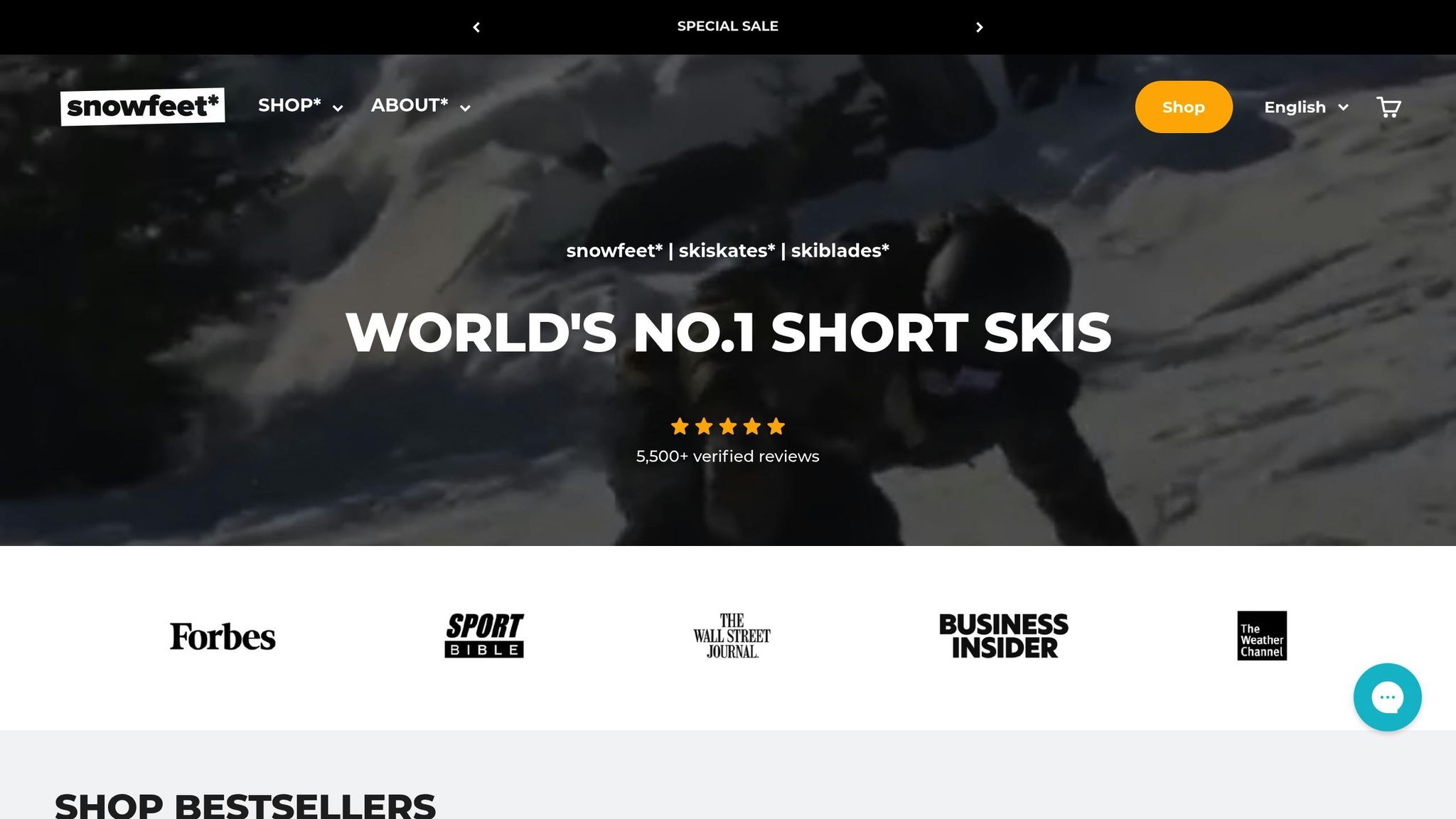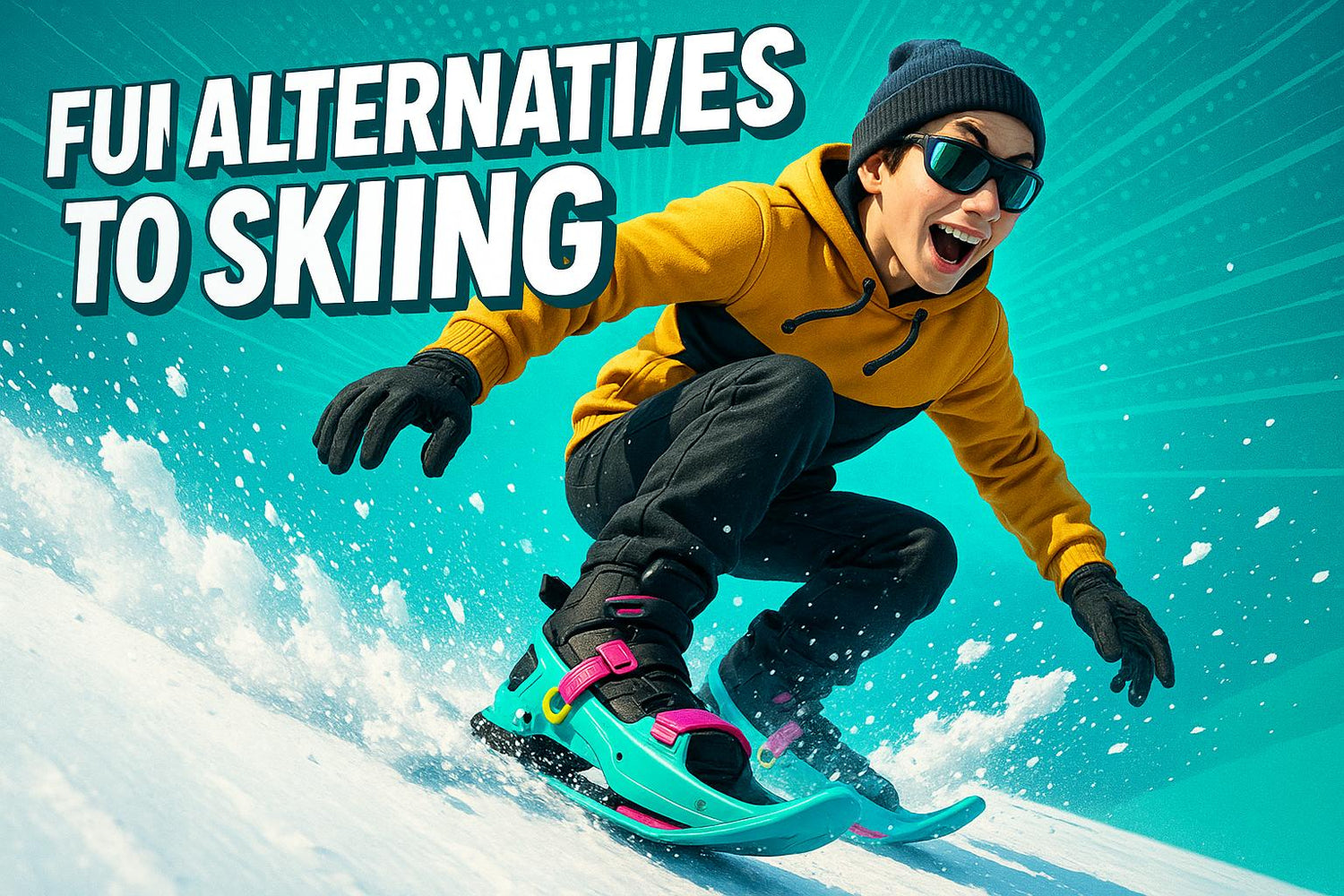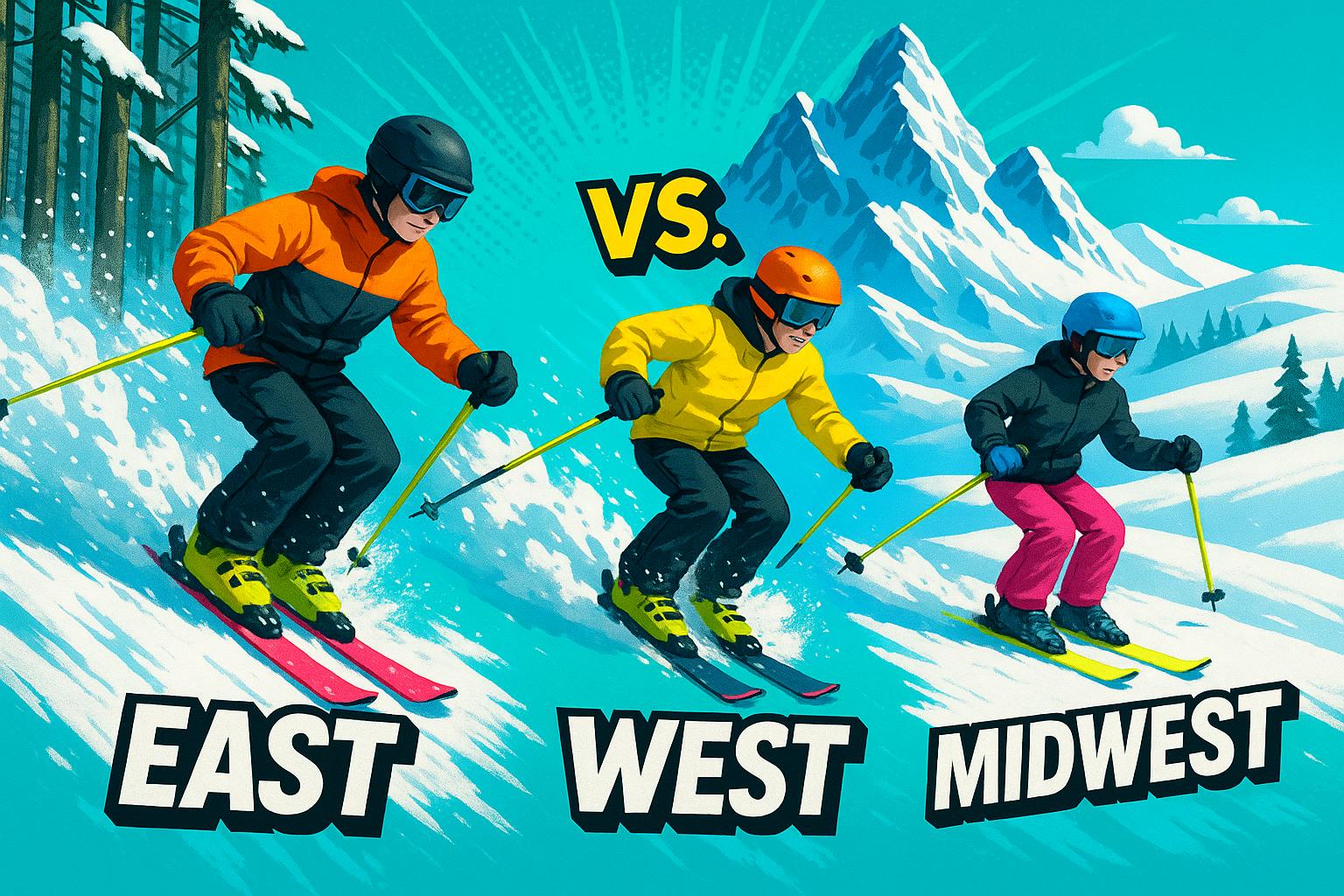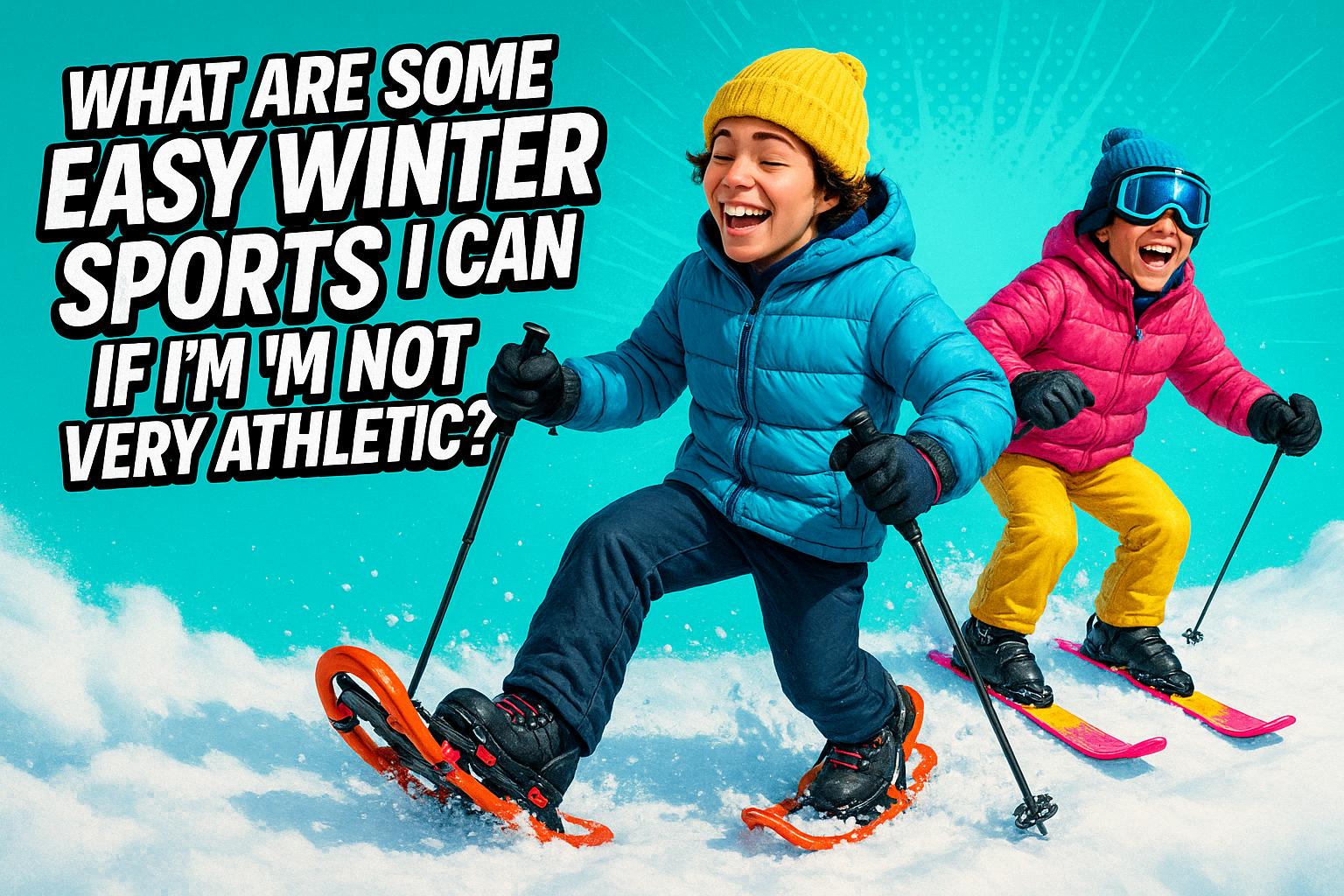Pokud nejste fanouškem dlouhých lyží nebo objemných snowboardů, Snowfeet* nabízí kompaktní, lehkou a snadno použitelnou alternativu pro zimní sporty. Tyto mini lyže kombinují rychlé pohyby bruslení s rychlostí lyžování, což je činí přátelskými pro začátečníky a univerzálními pro různé terény. Zde je důvod, proč vynikají:
- Přenosné: Vejdou se do batohu, na rozdíl od těžkého lyžařského vybavení.
- Snadné na naučení: Připněte je na své zimní boty nebo snowboardové boty a začněte klouzat během několika minut.
- Dostupné: Ceny se pohybují od 150 do 690 dolarů, což je mnohem levnější než kompletní lyžařské vybavení.
- Funguje kdekoli: Použijte je na sjezdovkách, v parcích, na stezkách nebo dokonce na vaší zahradě.
- Bezpečnější: Kratší délka snižuje riziko ve srovnání s tradičními lyžemi.
Rychlé srovnání
| Funkce | Snowfeet* | Dlouhé lyže (Rossignol/Atomic/Head) | Snowboardy (hlavní značky) |
|---|---|---|---|
| Přenosnost | Vejde se do batohu | Vyžaduje nosiče na auto nebo velké tašky | Objemné; vyžadují velké tašky |
| Křivka učení | Vhodné pro začátečníky | Strmé | Mírné až strmé |
| Požadované vybavení | Běžné boty | Specializované boty, hole, vázání | Snowboardové boty, vázání |
| Použitelné lokality | Sjezdovky, stezky, zahrady | Většinou lyžařská střediska | Většinou lyžařská střediska |
| Cenové rozpětí | $150–$690 | $400–$1,000+ | $300–$800+ |
Snowfeet* je zábavný, cenově dostupný a méně zastrašující způsob, jak si užít sníh, ať už jste začátečník nebo zkušený jezdec hledající něco nového.
Snowboardista zkouší Snowfeet* | Které Snowfeet* Short Ski je nejlepší? | Recenze Snowblades 44, 65, 99

Problémy s dlouhými lyžemi a snowboardy
Než se ponoříme do toho, co dělá Snowfeet* výjimečnými, pojďme se blíže podívat na některé běžné problémy spojené s tradičním lyžařským a snowboardovým vybavením. Zatímco značky jako Rossignol, Atomic, Head a Elan vytvořily vybavení, které dominuje trhu, jejich produkty často přinášejí řadu starostí. Od obtížné přepravy až po strmou učební křivku, tradiční vybavení není vždy tak okouzlující, jak se zdá.
Těžké na přenášení a skladování
Přiznejme si to - tradiční lyže a snowboardy jsou otrava na přenášení. Jsou velké, těžké a nepohodlné, což cestování s nimi ztěžuje. Už jste někdy zkoušeli projít letištěm s nadměrnou lyžařskou taškou? Nejenže se nevejdou do horních přihrádek, ale letecké společnosti rády přidávají poplatky za nadměrný zavazadlový prostor. A když necestujete, jejich skladování doma může být stejně frustrující, zvlášť pokud máte málo místa.
Trvá příliš dlouho, než se to naučíte
Ovládnutí lyžování nebo snowboardingu není zrovna víkendový projekt. Snowboarding má například zpočátku strmou učební křivku, zatímco lyžování vyžaduje zvládnout dvě lyže a hůlky. Jak říká lyžařský instruktor Oli Pringle:
"Lyžování se snadněji učí. Snowboard se snadněji ovládá."
Pro začátečníky často lyžování začíná technikou "pizza" nebo sněhového pluhu pro kontrolu rychlosti, zatímco snowboardisté musí rychle zvládnout ovládání hran - dovednost vyžadující rovnováhu a sílu středu těla. Každopádně je to proces, který vyžaduje čas, trpělivost a spoustu praxe.
Funguje jen na určitých místech
Tradiční lyže a snowboardy jsou docela vybíravé, kde vyniknou. Jsou navrženy pro upravené sjezdovky v lyžařských střediscích, a vzít je mimo vyšlapané cesty - například na zahradu nebo turistickou stezku - může být recept na frustraci. Dlouhé lyže zvlášť zápasí v úzkých prostorách a nerovném terénu. A jak jeden odborník poznamenává:
"Dlouhé lyže NIKDY neotáčejí tak dobře jako krátké. Krátké nikdy nejsou tak stabilní při vyšších rychlostech jako dlouhé."
Tento neustálý kompromis mezi stabilitou a ovladatelností omezuje, kde je můžete bezpečně používat. Drsný terén, stromy, muldy - to vše může z tradičního vybavení udělat spíše zátěž než přínos.
Potřeba drahého speciálního vybavení
Tradiční vybavení nejenže stojí hodně peněz - navíc vás zavazuje k určitému vybavení. Kompletní set od značek jako Elan nebo Head může snadno stát stovky až tisíce dolarů. A kvůli specializovaným botám a vázacím systémům jste často omezeni na používání jen určitého vybavení. Chcete kombinovat s vybavením, které už vlastníte? Na to zapomeňte.
Nebezpečnější
Velikost a rychlost tradičních lyží a snowboardů je může dělat nebezpečnými, zvlášť pro začátečníky. Lyžaři často čelí zraněním kolen při nešikovných pádech, zatímco snowboardisté si častěji zraní zápěstí nebo paže. Přidej k tomu strmou křivku učení a je jasné, jak dochází k nehodám. I drobné chyby při vysokých rychlostech mohou vést k vážným zraněním, což promění zábavný den na svahu v něco mnohem nebezpečnějšího.
Tyto výzvy zdůrazňují potřebu lepší, bezpečnější a všestrannější volby pro nadšence zimních sportů.
Proč produkty Snowfeet* fungují lépe
Už jsme mluvili o potížích s tradiční zimní výbavou, tak se pojďme podívat, proč Snowfeet* mění pravidla hry. Místo toho, aby se držely objemného, staromódního vybavení, se Snowfeet* zaměřuje na to, aby zimní sporty byly jednodušší, přenosnější a hlavně zábavnější. Nejsou to jen mini verze lyží – jsou to úplně nový způsob, jak si užít sníh. Tady je, jak Snowfeet* mění hru.
Malé a lehké na nošení
Jednou z nejvýraznějších vlastností vybavení Snowfeet* je, jak je kompaktní a lehké. Porovnej to s tradičními lyžemi od značek jako Head nebo Elan, které mohou být přes 5 stop dlouhé a vážit 10–15 liber za pár. Produkty Snowfeet*? Jsou jen zlomkem toho. Mini Ski Skates jsou dlouhé jen 15 palců (38 cm) – asi jako notebook. Dokonce i delší Skiblades, s délkou 47 palců (120 cm), jsou stále mnohem kratší než standardní lyže.
Tato přenosnost mění pravidla hry. Už žádné poplatky za nadměrnou zavazadla, žádné boje s nošením vybavení na letištích a žádná potřeba střešních nosičů na autě. Snowfeet* můžeš hodit do běžného batohu a rovnou vyrazit za dobrodružstvím. Ať už jdeš pěšky na nedotčené svahy, nebo se procházíš k sousednímu kopci, pohodlí je nepřekonatelné.
Jednoduché na použití
Snowfeet* dělá zimní sporty přístupné pro každého. Na rozdíl od tradičního lyžování, které často vyžaduje naučit se složité techniky jako pizza postoj, nebo snowboardingu, který vyžaduje hodiny praxe k zvládnutí rovnováhy a ovládání hran, jsou produkty Snowfeet* intuitivní. Můžeš je připnout a hned vyrazit.
Vezmi to od jednoho uživatele:
"Jo, už nějakou dobu jezdím na Snowfeet 50. Nevěděl jsem, co čekat, ale jsou fakt zábavné. Super lehké na nošení, prostě je připnu na boty na snowboard. Obvykle si hraju na menších kopcích, nic divokého, ale je to trochu jako bruslení, což se mi fakt líbí. Neříkám, že jsou pro každého, ale já jsem si to s nimi užil. Stojí za to je vyzkoušet, pokud jsi zvědavý." – Plus-Ebb-8696
Další fanoušek vyzdvihuje pohodlí:
"Zdá se, že atrakcí Snowfeet je, že nepotřebujete lyžařské boty. Pro Toma je ideální, že je může rychle nasadit a sundat, aniž by musel řešit těžké lyžařské boty." – jeffnyc
Nejlepší na tom? Můžete je používat s botami, které už vlastníte, což je ještě více usnadňuje začlenit do vaší zimní výbavy.
Práce s různými typy sněhu
Produkty Snowfeet* nejsou vybíravé, kde je používáte. Zatímco tradiční lyže jsou většinou navrženy pro upravené svahy, Snowfeet* vynikají v různorodosti. Ušlapaný sníh, POWDER nebo dokonce nerovný terén – tyto malé siláky zvládnou všechno. Jejich kratší délka je ideální pro úzké prostory, jako je proplétání mezi stromy nebo zdolávání muld, ale jsou stejně stabilní i na otevřených svazích.
Tato všestrannost otevírá svět možností. Můžete je vzít do lyžařských středisek, terénních parků, na turistické stezky nebo dokonce na svou zahradu, pokud je dost sněhu. Kdekoliv je zasněžený kopec, Snowfeet* ho promění ve vaše osobní hřiště.
Zábava pro začátečníky i experty
Ať už právě začínáte, nebo sjíždíte svahy už roky, Snowfeet* vás nezklame. Začátečníci si je mohou připnout a začít se bavit během minut – žádné zastrašující techniky, žádná strmá křivka učení. Jsou perfektním způsobem, jak se nenásilně ponořit do zimních sportů bez pocitu zahlcení.
Ale nemyslete si, že jsou jen pro začátečníky. Zkušení jezdci milují pocit podobný bruslení a obratnost, kterou tyto produkty nabízejí. Triky a manévry, které jsou s tradiční výbavou těžké nebo nemožné, se najednou stanou proveditelnými. Je to svěží, vzrušující výzva pro zkušené nadšence.
S možnostmi od kompaktních 15palcových (38 cm) Mini Ski Skates za 150 $ až po větší 47palcové (120 cm) Short Skis za 690 $, je tu něco pro každého. Ať už hledáte zábavu pro volný čas, nebo plánujete epické horské dobrodružství, Snowfeet* má model, který vyhoví vašim potřebám. Není to jen alternativa - je to zcela nový způsob, jak si užít zimu.
sbb-itb-17ade95
Snowfeet* vs Dlouhé lyže a snowboardy
Pojďme se podívat, jak si Snowfeet* stojí oproti tradičním možnostem jako dlouhé lyže a snowboardy. Zatímco velká jména jako Rossignol, Atomic a Head dominují svahy se svým vysoce výkonným vybavením, jejich objemné sestavy mají vážná omezení. Snowfeet* naopak nabízí svěží alternativu, která je lehká, všestranná a snadno použitelná.
Porovnávací tabulka vedle sebe
Zde je rychlý přehled, jak se Snowfeet* srovnává s tradiční výbavou:
| Funkce | Snowfeet* | Dlouhé lyže (Rossignol/Atomic/Head) | Snowboardy (hlavní značky) |
|---|---|---|---|
| Přenosnost | Vejde se do batohu | Vyžaduje nosiče na auto nebo nadměrné tašky | Objemné; vyžaduje nadměrné tašky |
| Křivka učení | Vhodné pro začátečníky | Strmé | Mírné až strmé |
| Požadované vybavení | Běžné zimní nebo snowboardové boty | Specializované lyžařské boty, hole a vázání | Snowboardové boty a vázání |
| Použitelné lokality | Sjezdovky, parky, stezky, dokonce i dvorky | Většinou lyžařská střediska a upravené sjezdovky | Většinou lyžařská střediska a upravené sjezdovky |
| Cenové rozpětí | $150–$690 | $400–$1,000+ | $300–$800+ |
| Hmotnost | Velmi lehké | Těžké | Těžké |
| Skladování | Kompaktní; snadné skladování | Vyžaduje značný prostor pro skladování | Vyžaduje značný prostor pro skladování |
| Univerzálnost | Funguje na různých terénech a podmínkách | Nejlepší pro specifické podmínky | Nejlepší pro specifické podmínky |
Když sečtete náklady, tradiční vybavení snadno přesáhne 800 dolarů, pokud započítáte boty, vázání a hole. Mezitím Snowfeet* stojí od 150 do 690 dolarů a nabízí cenově dostupnější možnost s stejně velkou zábavou a flexibilitou.
Teď, když jsme si představili čísla, podívejme se na to, co Snowfeet* skutečně odlišuje.
Co dělá Snowfeet* výjimečným
Jednou z největších výhod Snowfeet* je, že můžete používat své běžné zimní nebo snowboardové boty - nemusíte utrácet 200 až 500 dolarů za specializované lyžařské boty. To z něj dělá skvělou volbu pro rodiny nebo kohokoli, kdo chce vyzkoušet zimní sporty, aniž by musel utrácet velké peníze.
Snowfeet* také představuje zcela nový způsob, jak si užít sníh: skiskating. Představte si to jako mix bruslení a lyžování. Se Snowfeet* můžete předvádět skoky, otočky a triky, které jsou téměř nemožné s tradičními dlouhými lyžemi nebo snowboardy. Zatímco značky jako Rossignol a Head se zaměřují na rychlost a carving, Snowfeet* přináší na svahy hravý a kreativní nádech.
Další průlom? Nejste vázáni na lyžařská střediska. Snowfeet* funguje stejně dobře na místních kopcích, v parcích, na stezkách nebo dokonce na vaší zahradě. To znamená žádné drahé jízdenky na vleky ani dlouhé cesty do hor.
Skladování a přeprava jsou také hračka. Zapomeňte na střešní nosiče nebo objemné tašky - Snowfeet* se vejde do běžného batohu. To je obzvlášť praktické, pokud bydlíte v malém prostoru nebo bytě.
A pojďme si promluvit o učební křivce. S Snowfeet* většina lidí začne mít zábavu během několika minut. Naproti tomu tradiční lyžování často vyžaduje lekce a týdny praxe. Navíc jsou produkty Snowfeet* vyrobeny z odolného plastu vyztuženého skelnými vlákny, díky čemuž jsou lehčí a pevnější než lyže s dřevěným jádrem, které najdete u konvenční výbavy.
Snowfeet* není jen alternativa - je to zcela nový způsob, jak zažít zimu.
Který model Snowfeet* vybrat
Najít ten správný model Snowfeet* pro vaše zimní dobrodružství znamená sladit vaši úroveň dovedností, preferovaný terén a rozpočet. Ceny se pohybují od 150 do 690 dolarů, takže existuje produkt Snowfeet* pro každého. Tyto kompaktní, snadno použitelné alternativy k tradiční výbavě přinášejí zcela novou úroveň přenosnosti do vašich zasněžených výprav.
Všechny modely Snowfeet* vysvětleny
Snowfeet* má řadu navrženou tak, aby vyhovovala různým jezdcům:
- Mini Ski Skates (38 cm, 150 $): Nejmenší a nejpřenosnější možnost. Fungují s vašimi běžnými zimními botami a jsou perfektní pro rychlou, spontánní zábavu na sněhu.
- Snowfeet PRO (50 cm, 250 $): O krok výše v odolnosti a stabilitě, tento model vyvažuje přenosnost s výkonem. Je skvělou volbou pro ty, kteří chtějí trochu více kontroly než u Mini Ski Skates.
- Skiskates (44 cm, 390 $): Postavené s dřevěným jádrem jako tradiční lyže, jsou navrženy pro rychlost a přesnost na upravených svazích. Jsou ideální pro jezdce, kteří chtějí zvládnout skoky, otočky a triky.
- Skiblades: K dispozici ve třech délkách - 65 cm (450 $), 99 cm (490 $) a 120 cm (690 $) - tyto modely překlenou propast mezi skiskatingem a lyžováním. Verze 65 cm a 99 cm fungují s lyžařskými i snowboardovými botami, zatímco 120 cm Skiblades vyžadují lyžařské boty pro jejich vysokorychlostní, carvingový výkon.
Vázání se liší od Basic po Pro X, přičemž ten druhý nabízí větší odolnost a nastavitelnost.
Nejlepší model pro místo, kde lyžujete
Výběr správného modelu Snowfeet* závisí také na vašem oblíbeném terénu:
- Střediska a upravené svahy: Skiskates (44 cm) a Skiblades (65–120 cm) jsou vynikající volbou. Skiskates poskytují citlivé carvingové ovládání, zatímco delší Skiblades zajišťují stabilitu při vyšších rychlostech.
- Podmínky POWDER: 99 cm Skiblades zde vynikají, nabízejí obratnost a kontrolu, kterou delší lyže v hlubokém sněhu nemohou nabídnout.
- Všestranná dobrodružství: Na túry, běžecké cesty, sáňkování nebo dokonce zasněžené dvorky jsou perfektní Mini Ski Skates (38 cm) a Snowfeet PRO (50 cm). Jejich kompaktní velikost a kompatibilita se zimními botami je činí snadno přenosnými kamkoli.
- Freestyle a zábava v snowparku: Skiskates a kratší Skiblades jsou ideální pro triky, otočky a kreativní pohyby díky své obratnosti.
- Průzkum v terénu: Jakýkoli model Snowfeet* je pro to vhodný, protože jejich lehký design vás nezatíží na strmém nebo úzkém terénu.
Vyberte podle svých zkušeností a bot
Vaše obuv a úroveň zkušeností také hrají velkou roli při výběru správného modelu:
- Zimní boty: Pokud už vlastníte zimní boty, Mini Ski Skates (38 cm), Snowfeet PRO (50 cm) a Snowfeet Kids jsou skvělé možnosti. Není třeba investovat do drahých specializovaných bot.
- Sněžné boty: Tyto jsou kompatibilní s Mini Ski Skates, Snowfeet PRO, Skiskates a 65 cm a 99 cm Skiblades. Jsou také pohodlnější na chůzi a triky ve srovnání s lyžařskými botami.
- Lyžařské boty: Uživatelé lyžařských bot mohou zvolit Skiskates a kratší Skiblades (65 cm a 99 cm). Nicméně 120 cm Skiblades vyžadují lyžařské boty pro jejich vysoce výkonný design zaměřený na carving.
Pokud právě začínáte, Mini Ski Skates nebo Snowfeet PRO jsou cenově dostupné možnosti v rozmezí 150–250 $. Jsou snadné na naučení a většina lidí jezdí během několika minut - žádná dlouhá křivka učení jako u tradičních lyží.
Pro středně pokročilé a pokročilé jezdce, kteří jsou připraveni vyzkoušet něco nového, Skiskates nebo kratší Skiblades udržují vzrušení díky rovnováze výkonu a všestrannosti.
Odborní jezdci hledající špičkovou odolnost a nastavitelnost by měli zvážit modely s vázáním Pro X. 120 cm Skiblades ($690) jsou ultimátní volbou pro ty, kteří chtějí vysokorychlostní stabilitu s výhodami kratších lyží.
Nejlépe hodnocené modely Snowfeet* zahrnují Skiskates, 120 cm Short Skis a 65 cm Skiblades, všechny s hodnocením 5,0 hvězdiček. 50 cm Ski Skates nejsou daleko za nimi s impozantním hodnocením 4,9 hvězdiček.
Závěr: Lepší zimní sporty se Snowfeet*
Snowfeet* mění způsob, jakým zažíváme zimní sporty. Díky zaměření na jednoduchost, dostupnost a zábavu usnadnili každému užívat si sníh více než kdy dřív. Na rozdíl od tradičních lyžařských značek jako Rossignol, Atomic a Head, které spoléhají na delší a těžší vybavení, Snowfeet* dokazuje, že někdy méně znamená více.
S více než 5 500 ověřenými recenzemi a impozantním hodnocením 4,9 z 5 hvězdiček je jasné, že lidé Snowfeet* milují. Vanessa to nazývá "jedním z nejlepších nákupů, jaké jsem kdy udělala." Andrew B. říká: "Nikdy se nevrátím k původním lyžím" a Nathan F. popisuje to jako "Největší zábavu, jakou jsem kdy na sněhu měl." Courtney Luckadoo sdílela svůj příběh úspěchu:
"Zvládl jsem zelenou sjezdovku první večer - během 2 hodin! Podruhé, co jsme šli, jsem zvládl modrou sjezdovku!"
Co dělá Snowfeet* výjimečnými, je svoboda, kterou poskytují. Už nejste vázáni na střediska ani omezeni těžkým vybavením. Snowfeet* vám umožní prozkoumat jakýkoli zasněžený terén a dá vám svobodu vyřezávat si vlastní cestu.
Ať už jste začátečník, kterého tradiční lyžování děsí, nebo zkušený profík hledající něco nového, Snowfeet* přináší zpět čistou radost ze zimních sportů. Jejich motto říká vše:
"Nejzábavnější zimní sport. Skating potkává lyžování. A probouzí v tobě dítě."
Takže pokud jste připraveni přijmout jednodušší a vzrušující způsob, jak si užít sníh, vyzkoušejte Snowfeet*. Není to jen vybavení - je to úplně nový způsob, jak si hrát v zimní říši divů.
Často kladené otázky
Jsou Snowfeet bezpečnější než tradiční lyže a snowboardy?
Produkty Snowfeet, jako jsou Skiblades, jsou skvělou volbou pro začátečníky nebo kohokoli, kdo hledá bezpečnější a lépe ovladatelnou alternativu k tradičním lyžím a snowboardům. Jejich menší velikost usnadňuje kontrolu, což znamená ostřejší zatáčky a plynulejší manévrování. Tato lepší kontrola pomáhá snižovat pády – což je u delších a těžších tradičních lyží, které vyžadují více zkušeností, mnohem těžší. Další výhoda? Snowfeet fungují s běžnými zimními botami, takže se vyhnete nepohodlí a komplikacím s špatně padnoucími lyžařskými botami.
Vyrobené z plastů vyztužených skelnými vlákny a kovových hran lyží, Snowfeet jsou odolné a poskytují pevný záběr a kontrolu i na zledovatělých nebo nerovných površích. Tyto materiály je nejen činí trvanlivými, ale také zvyšují výkon a bezpečnost. Ať už jste v zimních sportech nováček, nebo jen hledáte jednodušší a zábavnější způsob, jak vyrazit na svah, Snowfeet nabízejí spolehlivou a příjemnou volbu bez strmého učebního křivky tradiční výbavy.
Mohu používat Snowfeet na všech typech sněhu, nebo existují specifické podmínky, kde fungují nejlépe?
Ano, Snowfeet jsou navrženy tak, aby zvládly všechny druhy sněhu – POWDER, upravené tratě i zledovatělé úseky. Jejich přizpůsobivost je činí skvělou volbou pro milovníky zimních sportů bez ohledu na úroveň dovedností. Vezměte si například Snowfeet PRO (50 cm), který je ideální pro ostré zatáčky a triky v parku. Naopak Snowfeet POWDER (99 cm) vyniká při jízdě v hlubokém sněhu.
Pokud ale plánujete zdolávat opravdu náročný terén, tradiční lyže od značek jako Rossignol nebo Atomic mohou být lepší volbou. Ale tam, kde Snowfeet opravdu vynikají, je jejich přenosnost, snadné použití a hlavně zábava. Jsou skvělou volbou pro většinu zimních dobrodružství!
Jaký typ bot funguje se Snowfeet a potřebuji k jejich použití něco navíc?
Výbava Snowfeet je navržena tak, aby pasovala na většinu zimních bot, včetně snowboardových, takže není třeba utrácet za speciální obuv. Připínají se na boty pomocí nastavitelných vázání, což je super snadné na použití – ideální pro začátečníky i zkušené dobrodruhy.
Pro nejlepší jízdu je dobré zvolit nepromokavé boty, které poskytují pevnou oporu kotníku. Tato kombinace zajišťuje pohodlí a kontrolu, když carvingujete svahy. Krása Snowfeet je v jejich jednoduchosti – žádné další vybavení ani zbytečné náklady. Stačí se připoutat a užít si svěží, zábavný způsob lyžování nebo snowboardingu!
Související blogové příspěvky
- Proč mě bolí lyžařské boty? Běžné příčiny a řešení [2025]
- Jak si užít lyžařský výlet, i když neumím lyžovat nebo snowboardovat?
- Existují alternativy ke sjezdovému lyžování, které jsou šetrnější k kolenům? (Možnosti [2025])
- Jaké jsou nějaké snadné zimní sporty, které mohu vyzkoušet, když nejsem moc atletický?


































Zanechte komentář
Tento web je chráněn službou hCaptcha a vztahují se na něj Zásady ochrany osobních údajů a Podmínky služby společnosti hCaptcha.